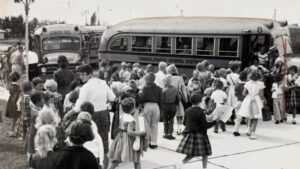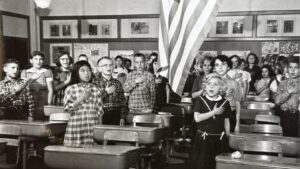May Friday History: What Have We Learned? School Construction in 1950
This year the Minnesota Association of School Board Officials (MASBO) celebrates 75 years of serving school business professionals. Coincidentally, the year 1950 was also a milestone year for Kraus-Anderson’s involvement in school construction. This week’s KA History Blog explores the factors that shaped this pivotal decade for both education and school construction. Above: The KA-built addition to Cyrus Northrop Elementary School, Minneapolis, 1950. Photos courtesy Minnesota Historical Society.
Kraus-Anderson has been active in school construction for 75 years. In 1950, as communities all over the nation were grappling with the need for new construction, KA rose to the challenge, working on about a dozen school projects throughout Minnesota between 1950-1951.
In 1950, the year MASBO was established, the U.S. was facing a soaring population of children about to enter the school system—a system of dated school facilities and processes that were greatly in need of attention.
The end of World War II is associated with the Baby Boom, the U.S. population surge that elevated enrollment in elementary and secondary schools by 52% by the early 1950’s.
As the federal government and the private sector endeavored to transition war time production to peace time needs, school districts were competing with hospitals, housing needs, manufacturing, bridges, streets, sidewalks and other demands on America’s infrastructure to accommodate the second half of the Twentieth Century.
Working to secure more than $50 million in federal appropriations funding toward Minnesota schools, in September 1950 Senator Hubert Humphrey put the issue in plain-spoken terms, saying,
“Children are attending school in barns, in hallways and in quonset huts. It is time that we acted to make it possible for them to get adequate facilities.”
Rising enrollments weren’t the only factor in the rapid onset of school construction in these years.
Demand Backlog
Beginning with the economic deprivation driven by the Great Depression from 1929-1941 and immediately followed by the rationing and defense production effort of World War II from 1941-1945, America’s public schools had been left largely untouched for two decades. Aging school facilities were not only cramped, but also all too often in need of repair, safety and other upgrades to provide adequate lighting, acoustics, heating and ventilation, electrical upgrades and updated equipment.
One KA school project in 1950 was for repairs to St. Paul’s Randolph Heights Elementary School, which a Star Tribune article reported as suffering from falling brick, stucco and further damage from water seepage, rendering the school unsafe.
Shifting Demographics

By 1950, young families were moving out of urban cores and into suburbs, further driving the demand for new school facilities in these communities. Moreover, one-room country schoolhouses that had one teacher for eight grades were by this time being consolidated into larger districts.
Supply Chain and Resource Allocation
Steel, copper and other supply chain delays/shortages occurred due to pent up demand across all construction markets, and as the nation converted to peacetime manufacturing and attempted to judiciously disperse federal aid for various uses. And, after an extremely expensive 1930’s and 1940’s, perhaps no commodity was so short as funding dollars.
A New War Looms
While the world war was over, the Cold War was just getting started. The Soviet Union entered the nuclear arms club in 1949 and was on its way to launching the first object in space- Sputnik- in 1957. By the early 1950s, the U.S. was in a race against time to bolster and secure its army of scientists, engineers and mathematicians.
In a February 1951 U.P. article about shortages of school facilities, Federal Education Commissioner Earl J. McGrath hinted at wartime rhetoric in stating his urgency for school construction.
“In an international emergency expenditures for many things can legitimately be reduced or postponed, but education is not one of them,” McGrath emphasized. “Democracy’s future depends on it.”

Building Public Engagement and Support
A key stratagy shaping schools’ future was outreach to build public engagement toward support of referendum levies, consolidations and modern approaches to education. In 1950, St. Paul and Minneapolis invited the public to a series of open house events to tour new schools and experience firsthand what modern school facilities had to offer, including fluorescent lighting, acoustical floor tiles, brightly colored walls, modern desks, cafeterias and multi-purpose gymnasium/auditoriums. A May 1950 Minneapolis Star article reports that 50,000 people attended “Modern School Day,” touring three of the district’s most modern schools including two suburban schools and one Minneapolis school, a recent addition to Cyrus Northrop Elementary School completed by KA. That addition included six new classrooms, a gymnasium/auditorium, stage, radio room and a community kitchen. Community use was another key factor in building public support.
“The rapidly growing concept of the school as a community center suggests the need for planning schools for a wider use than for children alone,” said Rufus A. Putnam, associate superintendent for business affairs of the Minneapolis Public Schools, speaking at Cyrus Northrop.
KA School Projects 1950-1951:
- 777,0333 SF South St. Paul Junior High School, S. St. Paul
- 210,000 SF Remodel/addition, Benson High School, MN school
- 28,500 SF Jefferson School addition, St. Paul
- School remodel/safety upgrades, Randolph Heights
- 483,000 SF North Side school and gymnasium, Albert Lea School (later renamed Hawthorne)
- 46,700 SF school bus garage, Dowling School, Mpls
- 57,750 SF school addition, McCarron’s Elementary School(?), St. Paul
- New southside school and addition to Lafayette School, 2 schools totaling 547,350 SF in Willmar, MN
- 124,000 SF school addition, Church of Christ the King
- Church and school, St. Louis Park Holy Trinity Church
- School addition, 149,200 SF, Hopkins Harley School
CATEGORY: Uncategorized